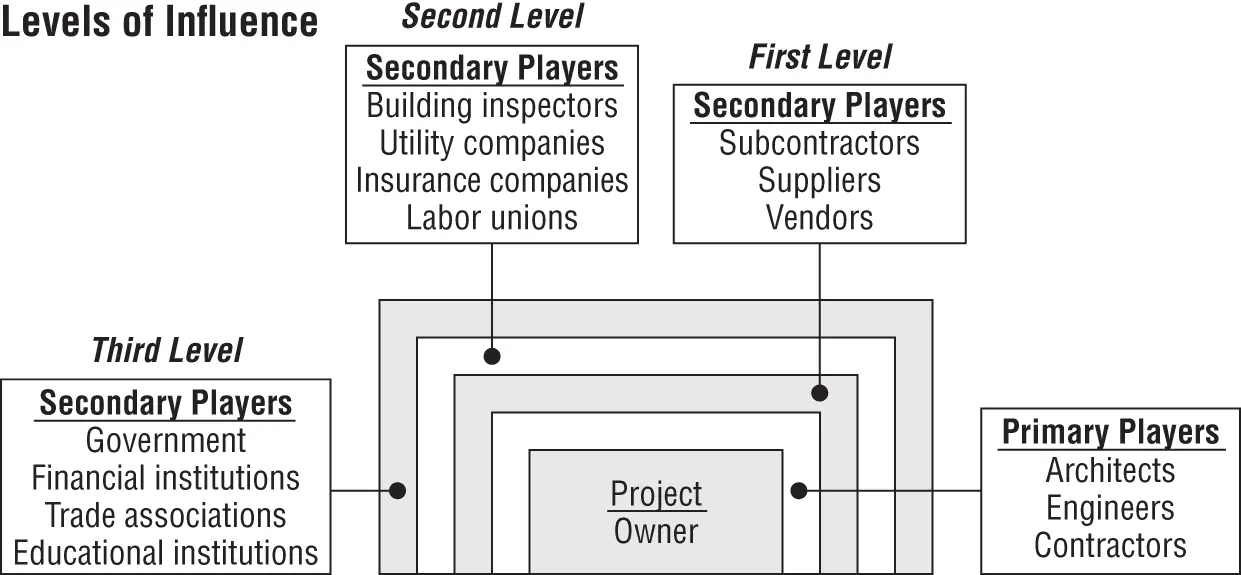There are many different engineering specialties; the most common ones associated with construction activities are described next:
Structural engineers Structural engineers design the timber, concrete, or steel structural systems that support a building and basically hold it up to withstand the forces of wind, gravity, and seismic activity. They design the foundations, beams, girders, and columns that make up the skeleton of the structure.
Mechanical engineers Mechanical engineers design the heating, cooling, ventilating, plumbing, and fire suppression systems within a building. They coordinate their efforts with the architectural design, the structural design, and the electrical design.
Electrical engineers Electrical engineers design and calculate electrical loads and determine the circuitry, lighting, motors, transformers, and telecommunications needed for a building. They typically work closely with the architect to ensure that the owner's expectations are met and often coordinate their efforts with the mechanical engineer.
Civil engineers Civil engineers design roads, bridges, tunnels, dams, site drainage, parking lots, runways, and water supply and sewage systems. Civil engineering, considered one of the oldest engineering disciplines, encompasses many specialties. Civil engineers are the ones who take the bare land and excavate it, move it, drill it, and shape it to meet the needs of the architectural design and the construction. Site work is one of the most unpredictable and expensive aspects of any construction project, and good design makes all the difference in the world.
I am including landscape architects as a separate design professional because they are. Many people do not understand the distinction, but landscape architects are professionals licensed and regulated by an entity separate from building architects. Landscape architects deal with the building site and outside environmental issues surrounding the structure. They are involved with such things as plantings, sidewalks, retaining walls, and water features to enhance the project. Large architectural firms may employ landscape architects on staff and utilize their services in the overall design. Or the landscape professional may be hired directly by the owner or work under a separate contract with the builder.
Great landscape design can make an ordinary building look extraordinary. Likewise, an ill-conceived landscape design can make an extraordinary building look ordinary. Unfortunately, many owners fail to see the significance of this design element and shortchange the budget for landscape design.
Not all projects will engage the services of an interior designer. They may be hired directly by the owner or be a consultant to the architect. They deal with the building's interior finishes or schemes and make decisions regarding furniture selection and placement, paint colors and accessories, light fixtures, window treatments, floor finishes, and ceiling treatments. The contractor may or may not have direct dealings with the interior designer.
Construction Professionals
According to the American Institute of Constructors, the term constructor is generally used to define the professional responsible for all construction activities whether they work as a general contractor, a construction manager, or a specialty contractor. The profession of constructor includes job titles such as, but not limited to, project manager, general superintendent, project executive, operations manager, construction manager, and chief executive officer. The constructor's job is to do the following:
Interpret the plans and specifications and prepare cost estimates and time schedules to meet the requirements of the owner.
Determine and implement the best construction practices, means, and methods to satisfy the owner's requirements for time, cost, and quality.
Oversee and manage all of the construction operations into a single, safe coordinated effort.
The general contractor, also known as the prime contractor , enters into a contract with the owner to deliver the construction project in accordance with the plans and specifications that have been prepared by the architects and engineers. They may or may not actually perform any of the actual construction work with their own forces. When they do, they are said to be doing self-performed work . When they don't, they arrange for subcontractors or trade contractors to perform the specialized craftwork such as excavation, concrete placement, painting, or plumbing. Today, more often than not, the general contractor maintains only a management staff and a field staff as permanent employees. The construction management staff includes estimators, schedulers, and purchasing agents, while the field management staff consists of superintendents, foremen, field engineers, and lead workers. The work of the trades is performed under separate subcontracts with various specialty contractors.
Construction work that is performed with the general contractor's own forces or labor. This is work that is not subcontracted.
Construction managers may be employed by construction management firms, general contractors, architects, engineers, owners, or specialty contractors. The primary responsibility of the construction manager is to organize the project team to perform the construction management function that is the topic of this entire book.
Specialty contractors are often referred to as subcontractors because they perform their work under a contract with another contractor (typically the general contractor) to do a portion of the contractor's work, as opposed to contracting directly with an owner. These subcontractors, in turn, may engage other subcontractors. Thus, there can be several levels of subcontracting to a general contractor.
It is important to include the trade workers as part of the construction professionals’ discussion because, without them, there would be no construction at all. These are the men and women (plumbers, electricians, ironworkers, and so on) who actually perform the work. These skilled and semi-skilled workers are the construction industry's most valuable asset, although they are rarely recognized for their immense contribution. Unfortunately, too, their ranks are dwindling to crisis proportions, despite relatively high compensation, because of decreased training opportunities, traditionally provided by labor unions and vocational schools. However, various trade associations such as the Associated General Contractors (AGC), Associated Builders and Contractors (ABC), and the National Association of Women in Construction (NAWIC) have tried to pick up the slack by introducing educational opportunities through special initiative programs.
Construction is second only to the restaurant business when it comes to high-risk business endeavors. Four out of five construction companies will go out of business during their first year. There are many factors for this. One of them is the power that outside parties have over the entire construction process and outcome. These secondary players, or what I call layers of influence , are beyond the immediate control of any of the primary players. I have divided these layers of influence into three levels.

Читать дальше













